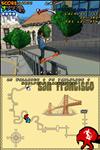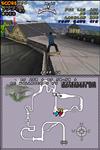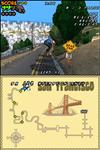Has it really been seven years since the first Tony Hawk video game was released? I remember really enjoying Tony Hawk Pro Skater on my Playstation 2, and how popular it was at the time (sales in excess of 1 million copies in 2000). Since then, Tony Hawk branded video games have become far more than a cottage industry, and as the 10th distinct title in the Tony Hawk armada, Tony Hawks Downhill Jam (THDJ, for short) for Nintendo DS shows that skateboarding games can still bring some new tricks.
Vicarious Visions, developer of THDJ has been developing Gameboy Advanced versions of the various Tony Hawk titles since mid 2001. And starting with last years Tony Hawk American Sk8land (THAS), they’ve been creating the DS versions as well.
With THDJ, you’re placed in a familiar Tony Hawk theme; Tony is starting a downhill racing team with the best skaters from all over the world, and he’s targeted you first. Beginning in San Francisco and traveling through Edinburgh, Rio, Hong Kong and others, your challenge is to recruit the best of the best in each city on the tour.
Each city has a unique track with a distinctive layout and features that make some semblance of sense for that area of the world. From a trip down the twists and turns of Lombard Street in San Francisco to a snow covered course in the mountains of Europe, the courses stand out from each other with different shortcuts, obstacles and unique views that help in keeping advancement through the game from becoming tedious. A nice feature is that during races, the touch screen is used to display a map of the course and your skaters location and direction on the course.
You conquer a track not by completing it, but rather by reach milestones on the track through multiple passes. Whether through reaching specific high score or combo levels, smashing a set number of destructible obstacles or just cruising through under a set time, you earn the ability to unlock unique tasks against the best skater in that specific city. Beat the skater at the task, and they’ll join your team. You don’t have to complete every goal to move on to the next city, rather just the ones that allow you to face the best skater.
There are a couple of nice little extras in some of the races that provide additional incentives for performing big air tricks. A few of the courses have objectives where you skate through a camera icon on the course, changing the viewing angle from directly behind the skater to a panoramic side view and changing to a slow motion mode to perform your tricks as they are often shown in extreme sports videos.
Most of the tricks used in the game are exactly the same as in THAS but apply quite a bit differently at the much higher speeds of the downhill setting. Where American Sk8land was a more relaxed, slow pace game of exploration and skating around town, THDJ is an over the top vertical trickfest, where building the best scores comes from continuous combinations of the top end tricks. Trick combos and well-executed “big air” tricks earn a boost that allows the skater to get both bigger air and faster course times. Combos are also easier than in THAS because the requirement to do a “revert” to continue a combo has been replaced by a 3 second timer. So long as you begin the next trick in the 3 seconds following your last, the combo continues. Special tricks become available as well for a skater who is scoring big. A single press on the touch screen executes these tricks during a downhill session, and really boosts the points for the run.
Another way to boost your score is by increasing the skills of your custom skater. You create a skater when you begin playing the game and can choose to play as this skater throughout the game, or skate as Tony Hawk or the other recruited skaters from the game. When you complete specific goals in the unlockable challenges in each city, you are given points to increase the speed, balance, air, and etc. of your skater in order to get better results to your tricks.
Of course, it wouldn’t really be a skateboard game without a proper skate shop. In the skate shop, you can customize your character, buy board art, clothes, cheats, and watch replays or view the scoreboards.
The purchasable cheats can be fun for the free skate mode, which keeps track of your most recent combo score as you take a run through any course you’ve completed to that point. If you want to race, but not work towards any specific goals, there’s also the free race and training modes, which are great for learning how to put together combos or work on getting the best balance on a grind.
The cell-shaded graphics are again similar in style to THAS, but are better than the previous games, and the backgrounds and courses, though somewhat littered with in game advertising for Tony Hawk sponsors among others, are crisp with sharp, identifiable images even for items in the distance. While not expecting top of the line graphics in the DS version of this game, I came away impressed, especially for graphics drawn at the speed the races moved at.
One area where things weren’t quite as quick was in WiFi play. First off, THDJ doesn’t support single cartridge multiplayer gaming, which so many of the releases for this platform list as a feature. This meant the only way I could play the game against live opponents was through a Nintendo WiFi hotspot. So it was off to my local McDonalds for a chance to race against others online. The hard part was finding players to compete against, although this is likely due to the amount of time the game had been released at time of review. I had no trouble finding a few 2-player games of elimiskate or big air, the names of which basically describe the goal of the games. I was not able to find enough players on line to play a 4-player match, but I found the 2-player games to be decent fun, and different enough from the solo player as to be worth the price of the double cheeseburger and fries I ate while playing.
The games audio was decent, if not exactly overwhelming. I’ve found that all audio on the DS Lite is better through headphones than the units’ speakers, and THDJ was no different. The soundtrack is comprised of pretty much the type of songs you’d expect from a skating game, though the sound quality wasn’t exactly what I had hoped, and gets a bit choppy while loading a multiplayer game or waiting for opponents online.
My only other issue with the game was with the controller setup. All of the trick and movement controls are laid out nicely except for one, the boost control. The buttons are so close together on the DS, that for someone like myself with larger fingers, using one finger to sometimes press two buttons right next to each other obtain the best possible lift off a ramp is literally a cramp causing maneuver.
In conclusion, I really enjoyed Downhill Jam. While it doesn’t offer the free-range play the last few Tony Hawk titles have been known for, the race play is not so contained as to not allow some feeling of freedom, especially when catching big air as a shortcut from one area of the game to the next.











